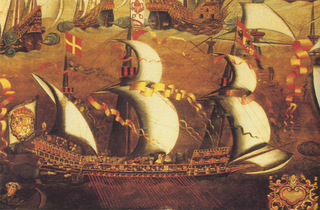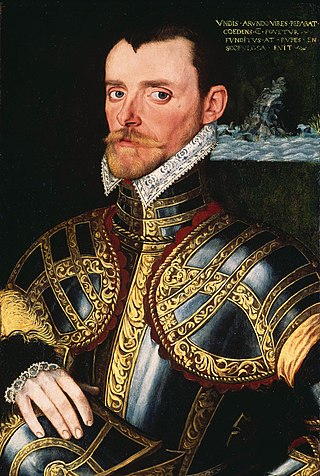| |||||
| Centuries: | |||||
|---|---|---|---|---|---|
| Decades: | |||||
| See also: | List of years in Scotland Timeline of Scottish history 1588 in: England • Elsewhere | ||||
Events from the year 1588 in the Kingdom of Scotland .
| |||||
| Centuries: | |||||
|---|---|---|---|---|---|
| Decades: | |||||
| See also: | List of years in Scotland Timeline of Scottish history 1588 in: England • Elsewhere | ||||
Events from the year 1588 in the Kingdom of Scotland .

Sir Francis Drake was an English explorer and privateer best known for his circumnavigation of the world in a single expedition between 1577 and 1580. This was the first English circumnavigation, and third circumnavigation overall. He is also known for participating in the early English slaving voyages of his cousin, Sir John Hawkins, and John Lovell. Having started as a simple seaman, in 1588 he was part of the fight against the Spanish Armada as a vice-admiral.

1588 (MDLXXXVIII) was a leap year starting on Friday of the Gregorian calendar and a leap year starting on Monday of the Julian calendar, the 1588th year of the Common Era (CE) and Anno Domini (AD) designations, the 588th year of the 2nd millennium, the 88th year of the 16th century, and the 9th year of the 1580s decade. As of the start of 1588, the Gregorian calendar was 10 days ahead of the Julian calendar, which remained in localized use until 1923.

1585 (MDLXXXV) was a common year starting on Tuesday of the Gregorian calendar and a common year starting on Friday of the Julian calendar, the 1585th year of the Common Era (CE) and Anno Domini (AD) designations, the 585th year of the 2nd millennium, the 85th year of the 16th century, and the 6th year of the 1580s decade. As of the start of 1585, the Gregorian calendar was 10 days ahead of the Julian calendar, which remained in localized use until 1923.
This article presents lists of the literary events and publications in 1588.

The Anglo-Spanish War (1585–1604) was an intermittent conflict between the Habsburg Kingdom of Spain and the Kingdom of England. It was never formally declared. The war included much English privateering against Spanish ships, and several widely separated battles. It began with England's military expedition in 1585 to what was then the Spanish Netherlands under the command of the Earl of Leicester, in support of the Dutch rebellion against Spanish Habsburg rule.

La Girona was a galleass of the 1588 Spanish Armada that foundered and sank off Lacada Point, County Antrim, on the night of 26 October 1588, after making its way eastward along the north coast of Ulster. The wreck is noteworthy for the great loss of life that resulted and the treasures recovered.

The Spanish Armada was a Spanish fleet that sailed from Lisbon in late May 1588, commanded by the Duke of Medina Sidonia, an aristocrat without previous naval experience appointed by Philip II of Spain. His orders were to sail up the English Channel, link up with the Duke of Parma in Flanders, and escort an invasion force that would land in England and overthrow Elizabeth I. Its purpose was to reinstate Catholicism in England, end support for the Dutch Republic, and prevent attacks by English and Dutch privateers against Spanish interests in the Americas.
The Spanish Armada in Ireland refers to the landfall made upon the coast of Ireland in September 1588 of a large portion of the 130-strong fleet sent by Philip II to invade England.
Francisco de Cuéllar was a Spanish sea captain who sailed with the Spanish Armada in 1588 and was wrecked on the coast of Ireland. He gave a remarkable account of his experiences in the fleet and on the run in Ireland.
Events from the 1580s in England.
Events from the 1590s in England.
The Armada of 1779 was a combined Franco-Spanish naval enterprise intended to divert British military assets, primarily of the Royal Navy, from other war theatres by invading the Kingdom of Great Britain during the American Revolutionary War. This action was a part of the wider Anglo-French War (1778–1783). The proposed plan was to seize the Isle of Wight and then capture the British naval base of Portsmouth. Ultimately, no fleet battles were fought in the Channel and the Franco-Spanish invasion never materialized. This threat to Great Britain prompted comparisons to the earlier Spanish Armada of 1588.

The Sea Dogs were a group of English privateers authorised by Queen Elizabeth I to raid England's enemies, whether they were formally at with war with them or not. Active from 1560 onwards until Elizabeth's death in 1603, the Sea Dogs primarily attacked Spanish targets, both on land and on sea, particularly during the Anglo-Spanish War. Members of the Sea Dogs, including Sir John Hawkins and Sir Francis Drake, also engaged in illicit slave trading with Spanish colonies in the Americas.
The term Invasion of England may refer to the following planned or actual invasions of what is now modern England, successful or otherwise.
The San Esteban was a ship of the Spanish Armada that was wrecked on the west coast of Ireland in 1588. All the survivors were killed when they reached the shore or taken prisoner and later hanged.
Events in the year 1588 in Spain.

The 2nd Spanish Armada also known as the Spanish Armada of 1596 was a naval operation that took place during the Anglo–Spanish War. Another invasion of England or Ireland was attempted in the autumn of 1596 by King Philip II of Spain. In an attempt at revenge for the English sack of Cadiz in 1596, Philip immediately ordered a counter strike in the hope of assisting the Irish rebels in rebellion against the English crown. The strategy was to open a new front in the war, forcing English troops away from France and the Netherlands, where they were also fighting.

The official history of the Royal Navy began with the establishment of the Navy Royal by Henry VIII in 1546. The modern incarnation of the institution re-emerged as the national naval force of the Kingdom of England in 1660, following the Restoration of King Charles II to the throne. However, for more than a thousand years before that there had been English naval forces varying in type and organization. In 1707 it became the naval force of the Kingdom of Great Britain after the Union between England and Scotland which merged the English navy with the much smaller Royal Scots Navy, although the two had begun operating together from the time of the Union of the Crowns in 1603.